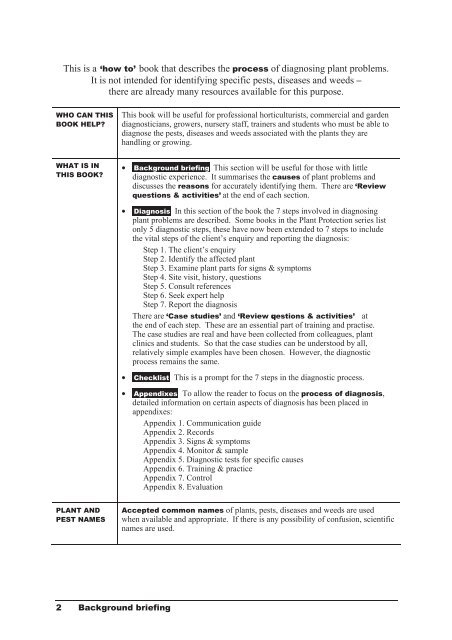PLANT PROTECTION 4
PLANT PROTECTION 4
PLANT PROTECTION 4
You also want an ePaper? Increase the reach of your titles
YUMPU automatically turns print PDFs into web optimized ePapers that Google loves.
This is a ‘how to’ book that describes the process of diagnosing plant problems.<br />
It is not intended for identifying specific pests, diseases and weeds –<br />
there are already many resources available for this purpose.<br />
WHO CAN THIS<br />
BOOK HELP?<br />
WHAT IS IN<br />
THIS BOOK?<br />
<strong>PLANT</strong> AND<br />
PEST NAMES<br />
2 Background briefing<br />
This book will be useful for professional horticulturists, commercial and garden<br />
diagnosticians, growers, nursery staff, trainers and students who must be able to<br />
diagnose the pests, diseases and weeds associated with the plants they are<br />
handling or growing.<br />
• Background briefing This section will be useful for those with little<br />
diagnostic experience. It summarises the causes of plant problems and<br />
discusses the reasons for accurately identifying them. There are ‘Review<br />
questions & activities’ at the end of each section.<br />
• Diagnosis In this section of the book the 7 steps involved in diagnosing<br />
plant problems are described. Some books in the Plant Protection series list<br />
only 5 diagnostic steps, these have now been extended to 7 steps to include<br />
the vital steps of the client’s enquiry and reporting the diagnosis:<br />
Step 1. The client’s enquiry<br />
Step 2. Identify the affected plant<br />
Step 3. Examine plant parts for signs & symptoms<br />
Step 4. Site visit, history, questions<br />
Step 5. Consult references<br />
Step 6. Seek expert help<br />
Step 7. Report the diagnosis<br />
There are ‘Case studies’ and ‘Review questions & activities’ at<br />
the end of each step. These are an essential part of training and practise.<br />
The case studies are real and have been collected from colleagues, plant<br />
clinics and students. So that the case studies can be understood by all,<br />
relatively simple examples have been chosen. However, the diagnostic<br />
process remains the same.<br />
• Checklist This is a prompt for the 7 steps in the diagnostic process.<br />
• Appendixes To allow the reader to focus on the process of diagnosis,<br />
detailed information on certain aspects of diagnosis has been placed in<br />
appendixes:<br />
Appendix 1. Communication guide<br />
Appendix 2. Records<br />
Appendix 3. Signs & symptoms<br />
Appendix 4. Monitor & sample<br />
Appendix 5. Diagnostic tests for specific causes<br />
Appendix 6. Training & practice<br />
Appendix 7. Control<br />
Appendix 8. Evaluation<br />
Accepted common names of plants, pests, diseases and weeds are used<br />
when available and appropriate. If there is any possibility of confusion, scientific<br />
names are used.







![[Compatibility Mode].pdf](https://img.yumpu.com/27318716/1/190x135/compatibility-modepdf.jpg?quality=85)









